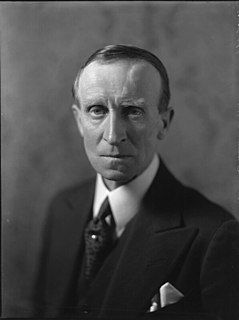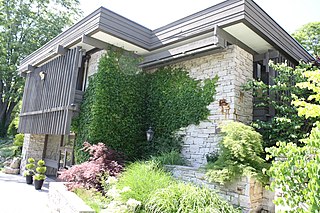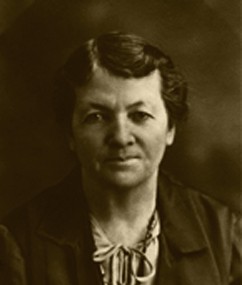
Trillium erectum, the red trillium, also known as wake robin, purple trillium, bethroot, or stinking Benjamin., is a species of flowering plant in the family Melanthiaceae. The plant takes its common name "wake robin" by analogy with the European robin, which has a red breast heralding spring. Likewise Trillium erectum is a spring ephemeral whose life-cycle is synchronized with that of the forests in which it lives. It is native to the eastern United States and eastern Canada from northern Georgia to Quebec and New Brunswick.

John Buchan, 1st Baron Tweedsmuir was a Scottish novelist, historian, and Unionist politician who served as Governor General of Canada, the 15th since Canadian Confederation.
The Worshipful Company of Gardeners is one of the Livery Companies of the City of London. An organisation of Gardeners existed in the middle of the fourteenth century; it received a Royal Charter in 1605. The Company no longer exists as a regulatory authority for the sale of produce in London; instead serving as a charitable institution. The Company also performs a ceremonial role; it formally presents bouquets to the Queen and to Princesses upon their wedding, anniversary, or other similar occasion.

Sir Edmund Walker Head, 8th Baronet, KCB was a 19th-century British politician and diplomat.
The Ontario Horticultural Association (OHA) is a horticultural organization in Ontario, Canada. It was organized in 1905, established in 1906, and incorporated by the Government of Ontario in 1924 via an Act in the Ontario Legislature, which split the Agricultural and Horticultural Societies into the Ontario Agricultural Fairs Association and the OHA. Its founding motto was "Keeping Ontario Beautiful".
The 8th Parliament of the Province of Canada was in session from 1863 to July 1866. Elections for the Legislative Assembly were held in the Province of Canada in August 1863. Sessions were held in Quebec City until 1866; the last session was held in Ottawa.

Vere Brabazon Ponsonby, 9th Earl of Bessborough, was an Anglo-Irish businessman and politician who served as Governor General of Canada, the fourteenth since Canadian Confederation.

The Central Experimental Farm (CEF), commonly known as the Experimental Farm, is an agricultural facility, working farm, and research centre of the Research Branch of Agriculture and Agri-Food Canada. As the name indicates, this farm is centrally located in and now surrounded by the City of Ottawa, Ontario, Canada. The 4 square kilometres (1.5 sq mi) farm is a National Historic Site of Canada and most buildings are protected and preserved as heritage buildings.
The Victoria Medal of Honour (VMH) is awarded to British horticulturists resident in the United Kingdom whom the Royal Horticultural Society Council considers deserving of special honour by the Society.
Trevor Jack Cole was a non-fiction author specializing in gardening topics. He was based in Ottawa, Ontario, Canada at Kinburn.

A garden grown specifically for the purpose of testing and evaluating plants is called a trial garden. Universities, plant breeders, and garden-industry companies frequently have trial gardens, as do many private and public botanical gardens and professional garden journalists. In the classic trials model, newly developed varieties of plants are compared with the closest similar industry standard plant throughout their life cycle—from germination/propagation through maturity, from seed to harvest. By growing new varieties side-by-side with existing ones, researchers can determine whether these new varieties are indeed better, and, if so, in what respects.

Beechwood Cemetery, located in Ottawa, Ontario, is the National Cemetery of Canada. It is the final resting place for over 82,000 Canadians from all walks of life, such as important politicians like Governor General Ramon Hnatyshyn and Prime Minister Sir Robert Borden, Canadian Forces Veterans, War Dead, members of the Royal Canadian Mounted Police, and men and women who have made a mark on Canadian history. In addition to being Canada's National Cemetery, it is also the National Military Cemetery of Canada and the Royal Canadian Mounted Police National Memorial Cemetery. A woodland cemetery founded in 1873, it is 64.7 hectares and is the largest cemetery in the city of Ottawa.
In Canada, a number of sites and structures are named for Governors General of the country, the Canadian monarch's representative in the country.

The Toronto Botanical Garden (TBG) is located at 777 Lawrence Avenue East at Leslie Street, in Toronto, Ontario, Canada. Termed "The little garden with big ideas", the TBG is nearly four acres and features 17 themed "city-sized gardens". Located in the north-east corner of Edwards Gardens, the TBG is a non-profit horticultural and educational organization with a mission to connect people, plants and the natural world through education, inspiration and leadership.
Isabella Preston was a horticulturalist and public servant widely recognized for her achievements in plant hybridization and extensive work in ornamental plant breeding. During her 26-year career, she produced nearly 200 new hardy hybrids of lily, lilac, crab apple, iris and rose plants for Canada's cold climate. While female plant breeders were rather rare in her day, she quietly challenged gender bias and set the stage for new generations of breeding programs at the Central Experimental Farm in Ottawa, Ontario, Canada and elsewhere.
James William Matthews, was a New Zealand newspaper editor, gardening writer, and horticulturist. In the 1940s, he founded the monthly magazine New Zealand Gardener.

Fannie Mahood Heath was an American gardener who discovered methods for growing imported flowers. She created flower and fruit cultivars and corresponded and collaborated with academics. She was a founding member and vice-president of the National Horticultural Society and her garden would attract 100 visitors a week.









